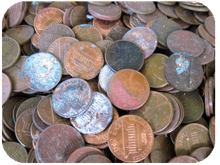 There are many today who feel that the time has come to retire the penny even though it has been a mainstay of American currency for centuries. The venerable Abraham Lincoln-emblazoned coin has without a doubt seen better times. In 1913 it possessed 25 times more purchasing power than it does currently. The penny also used to be profitable to produce. In 1990 it cost 0.6¢ to make one of the copper-coated coins, resulting in a yield of 0.4¢ per penny. Producing the penny hasn’t been profitable since 2006, however, and now each 1¢ coin costs 2¢ to mint.
There are many today who feel that the time has come to retire the penny even though it has been a mainstay of American currency for centuries. The venerable Abraham Lincoln-emblazoned coin has without a doubt seen better times. In 1913 it possessed 25 times more purchasing power than it does currently. The penny also used to be profitable to produce. In 1990 it cost 0.6¢ to make one of the copper-coated coins, resulting in a yield of 0.4¢ per penny. Producing the penny hasn’t been profitable since 2006, however, and now each 1¢ coin costs 2¢ to mint.
In his 2013 budget, President Obama proposed that the government explore new ways to structure currency so that the penny could be discontinued at last. He’s far from the first world leader to suggest ditching the 1¢ piece. Canada ceased penny circulation on February 4 of this year while Australia has been penny-free since 1990. The Canadian government estimates it will save $4 million a year by eliminating the coin. After all, so many monetary transactions are conducted electronically these days that cash itself is becoming increasingly obsolete. If a $20 bill isn’t as powerful as it used to be, what does that mean for a coin with almost no practical value?
Still, the penny has its fair share of defenders, namely the minters who earn a lot of money producing them. These companies and the lobbyists they fund argue that phasing out the 1¢ coin will inflict a number of adverse effects on the economy. First of all, an unintentional “rounding tax” could occur as many companies with prices that end in a 9 round their prices up to the nearest nickel. One controversial 1990 study claimed that this could end up costing consumers as much as $1.5 billion over five years. However, another study in 2006 found that businesses would end up saving $730 million annually by eliminating the time wasted dealing with the coin in cash transactions. But pro-penny activists do have one compelling argument on their side. If the penny is phased out, then U.S. currency will become more dependent on nickels. The 5¢ coin costs 10¢ to produce, negating any savings made by discontinuing the penny. One solution devised by economists includes eliminating the nickel and rounding all prices to the nearest dime, but that’s another argument entirely.
Questions:
- Has the penny outlived its usefulness?
- Does rounding a purchase up to a nickel or dime sound like a good alternative?
Source: Josh Sanburn, “Waiting For Change,” Time, February 4, 2013. Photo by David D.
